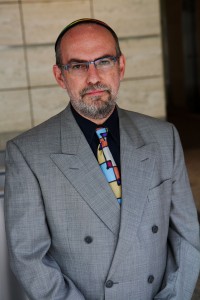 Aryeh Cohen the author of the book Justice in the City: An Argument from the Sources of Rabbinic Judaism is a professor, a social justice activist, a rabbi and a lecturer.
Aryeh Cohen the author of the book Justice in the City: An Argument from the Sources of Rabbinic Judaism is a professor, a social justice activist, a rabbi and a lecturer.
He teaches all things Rabbinic Literature (Mishnah, Talmud, midrash) and social justice at the Ziegler School for Rabbinic Studies of the American Jewish University, where he was ordained as a rabbi in 2010.
He is the Rabbi-in-Residence for Bend the Arc: A Jewish Partnership for Justice in Southern California.
Prof. Cohen is a founder and member of the Shtibl Minyan, and a board member of CLUE.

Dear Aryeh Cohen,
Thank you so much for the reminder that philosophy is the wisdom of love.
Love,
Kent Rossiter
Pingback: The Foreclosure Crisis as a Moral Crisis | Justice in the City
Dear Prof. Cohen,
Perhaps a concept taught in Law and Economics will be useful– the idea of externalized costs. This idea points out that some of the costs of producing a product are not borne by the producer or user of the product, but by large numbers of often-overlooked, victimized third parties. For example, the cost of burning fossil fuels includes the cost of air pollution, with its attendant greenhouse gases, climate change, and the destructive storms generated thereby. Of course, there are also the illness and treatment costs of the harmful substances in polluted air (and water and soil, etc.). In the gun control cases, there are the various costs involved with the murder of innocent persons by angry individuals with assault weapons who invade schoolgrounds, workplaces, theatres, etc. These costs are actually quite high, when you consider the long- and short-term medical and personal costs of the trauma, physical and mental, to the victims and their families; as well as the other damages which the courts commonly recognize, such as lifetime loss of earnings and of the companionship that the victims would have provided to their loved ones. Thus, the damages resulting from the murder of twenty-odd first-graders and their teachers at Sandy Hook alone might have been well over forty million dollars if current law compensated for damages as it often does in typical court cases of product liability. Since the law does not now provide for such compensation for the innocent gun victims, the costs are being paid by the economic losses, personal suffering, and trauma experienced by these direct and indirect victims.
The standard method for shifting the risk of harm done by a popular product is to set up a system by which the producers and buyers of the product pay for insurance to compensate those who suffer harm done by its production and distribution.
Whatever social benefit provided by ready availability of assault weapons should be paid by the various beneficiaries of the present gun laws which make such weapons readily available. The producers and buyers should provide insurance to compensate the victims of this trade. If such arrangements became adopted, the objection might be raised that the cost of insuring to provide such compensation might exceed the private advantage/profit currently flowing to the manufacturers and buyers of such weapons, and thereby diminish, perhaps eliminate, this production and distribution.
But that is the point: Forcing innocent victims rather the beneficiaries to pay for the harm done, is manifestly unjust. Justice lies in making the beneficiaries pay the costs, and if these real costs are too high for the trade to be profitable, why then, the product does not deserve to be made available to begin with.
These are all good points. Thank you.
If you search the Guns and Gun Violence category in the blog you will find the many places where I address gun violence.
Pingback: The hope to which we are called – St. Andrew's Memorial Church – Jerusalem
Pingback: The hope to which we are called – After Jerusalem, what?